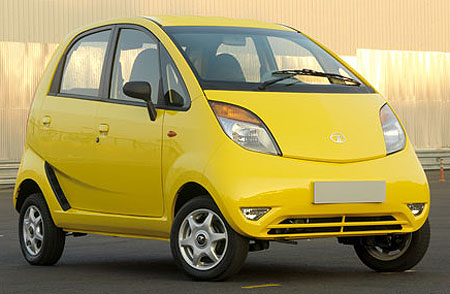
The Tata 1 Lakh Car was unveiled recently and it was given the name Tata Nano. We know its small, egg-like and comes with a small two-cylinder engine, but what exactly did Tata do to achieve the now famous “1 Lakh” price?
- Base 1-lakh model has no radio, power steering, power windows or air conditioning.
- Instrument panel only has the basics – speedometer, odometer and fuel gauge.
- Its 12 inch wheels only need 3 lug nuts.
- Small 12 inch tyres are cheaper because they use less material.
- The 624cc two-cylinder gasoline engine only has a single balance shaft.
- Does not pass US emission or safety standards.
- Bosch’s 35 amp generator is lighter than the usual 40 amp model.
- Bosch used a motorcycle starter motor.
- Bosch Value Motronic ECU removes 700 of the Motronic’s 1,000 functions, and the chip and housing itself has been shrinked.
- ECU sensors are smaller and lighter and fewer – 4 instead of the usual 7 or 8.
- Throttle position sensor is half its usual size because the pressure plate uses more sensitive material.
- It looks like a hatch but isn’t a hatch – the rear is welded shut and cannot be opened, this means the engine bay which lies under the rear seats also can only be accessed from inside the car.
- Drum brakes all-round instead of front discs.
- The basic 1-lakh model does not even come with a brake booster or servo.
- Reduced NVH materials, instead sheet metal frequencies were designed to control boom and vibration.
- Seats have a built in headrest and do not recline.
- No glovebox.
That’s basically the laydown of what cost-cutting measures Tata have taken to bring the Tata Nano’s price down to slightly more than 1-Lakh. Would you buy the Tata Nano if it was available in Malaysia?
Related Posts:
More photos of the Tata Nano
Tata Nano – the name of the Tata 1-Lakh car
Looking to sell your car? Sell it with Carro.


AI-generated Summary ✨
Comments on the Tata Nano focus on its affordability, with many noting it is a good option for low-income families or as an upgrade from bikes. Some feel it’s very basic, lacking safety features like airbags and air conditioning, making it less suitable for Malaysia’s climate and road conditions. There are concerns about its speed limit (around 70kph) and safety, with some comparing it to riding a motorcycle—less safe on highways. Several comments highlight its engineering and the effort by Tata to produce a cheap, fuel-efficient car, but critics see it as a cost-cutting measure that compromises quality and safety. Overall, opinions are mixed, with skeptics wary of its safety and practicality, while proponents recognize its potential for those seeking affordable mobility.